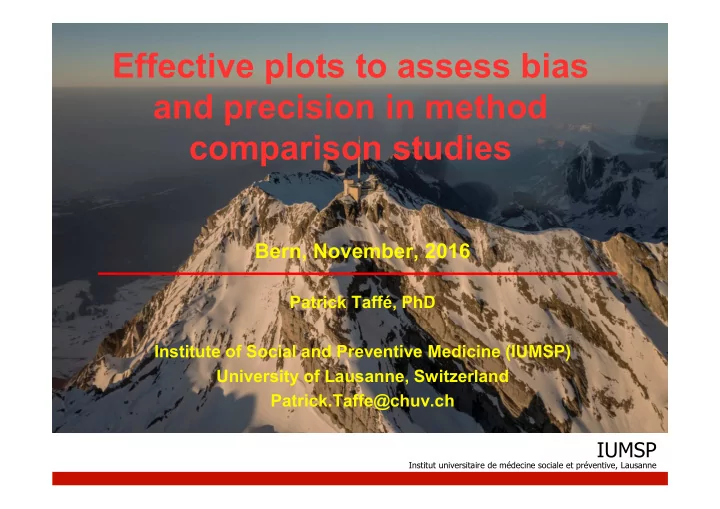

Effective plots to assess bias and precision in method comparison studies Bern, November, 2016 Patrick Taffé, PhD Institute of Social and Preventive Medicine (IUMSP) University of Lausanne, Switzerland Patrick.Taffe@chuv.ch ����� ������������������������������������������������������������������
Outline • Bland & Altman’s limits of agreement method (1986) • Extension to proportional bias and heteroscedasticity (1999) • A new methodology to quantify bias and precision • Illustration with a simulated example ����� ������������������������������������������������������������������ 2
How to measure agreement between two measurement methods ? Ex: blood pressure STATISTICAL METHODS FOR ASSESSING AGREEMENT BETWEEN TWO METHODS OF CLINICAL MEASUREMENT � ����������������������������������� ��������������������������������������������������������������������������������������� �� �����!�������"#$�%&�'�������(������������������������������&�����������&������ � ��������)��� *��+�,��+����������������*����������-� � . ������ ��#/01'� i: 23$42#35� � Statistical methods for assessing agreement between two ... www.ncbi.nlm.nih.gov/pubmed/2868172 Cited by 35451 - by JM Bland - 1986 - Related articles Lancet. 1986 Feb 8;1(8476):307-10. ������������������������ ���������������������������������������������������� ����� ����������� . Bland JM, Altman DG. ������������������������������������������������������������������ 3
Bland & Altman (1986) : They wanted a measure of agreement which was easy to estimate and to interpret for a measurement on an individual patient. An obvious starting point was a plot of the differences versus the mean of the measurements by the two methods : ����� ������������������������������������������������������������������ 4
The bias (differential bias) between the two measurement methods is estimated by the mean difference : bias mean ����� ������������������������������������������������������������������ 5
If the differences are normally distributed, we would expect about 95% of the differences to lie between the mean +- 1.96*SD, the so called limits of agreement (LoA) (Bland & Altman, 1986): ����� ������������������������������������������������������������������ 6
The decision about what is acceptable agreement is a clinical one: We can see that the blood pressure machine (S) may give values between 55mmHg above the sphygmomanometer (J) reading to 22mmHg below it, => such differences would be unacceptable for clinical purposes ����� ������������������������������������������������������������������ 7
However, these estimates are meaningful only if we can assume bias and variability are uniform throughout the range of measurement, assumptions which can be checked graphically: => assumptions approximatively met ����� ������������������������������������������������������������������ 8
In some cases the variability of the measurements increases with the magnitude of the latent trait (heteroscedasticity), as well as with the mean difference (proportional bias): Plasma volume data (Bland & Altman, 1999) 18 14 difference: Nadler-Hurley 10 6 2 -2 60 80 100 120 140 average: (Nadler+Hurley)/2 Plasma volume expressed in percentage of normal value: as measured by Nadler and Hurley ����� ������������������������������������������������������������������ 9
In this case, a linear regression of the differences on the averages can be estimated along with the LoA (Bland & Altman, 1999): Plasma volume data (Bland & Altman, 1999) 18 difference: Nadler-Hurley 14 10 6 2 -2 60 80 100 120 140 average: (Nadler+Hurley)/2 difference linear prediction upper 95% LoA lower 95% LoA Plasma volume expressed in percentage of normal value: as measured by Nadler and Hurley ����� ������������������������������������������������������������������ 10
In that case, the LoA are more difficult to interpret Plasma volume data (Bland & Altman, 1999) 18 (width not constant), difference: Nadler-Hurley 14 10 6 2 -2 and more importantly, 60 80 100 120 140 average: (Nadler+Hurley)/2 difference linear prediction upper 95% LoA lower 95% LoA there are settings where Bland & Altman’s plots are misleading ! Indeed, we will show that when variances of the measurement errors of the two methods are different, Bland and Altman’s plots may be misleading5 ����� ������������������������������������������������������������������ 11
Simulated examples where the regression line shows an upward or a downward trend but there is no biasJ LoA mu_Y1=9.61 mu_Y2=9.99 sig2_y1=60.56 sig2_y2=34.69 sig2_e1=26.25 sig2_e2=1.00 biais = 0.38 20 10 difference: y1-y2 LoA mu_Y1=10.33 mu_Y2=10.28 sig2_y1=34.68 sig2_y2=69.12 sig2_e1=0.95 sig2_e2=36.41 biais = -0.04 0 20 -10 10 difference: y1-y2 -20 0 -10 0 10 20 30 average: (y1+y2)/2 -10 difference Linear prediction upper2 lower2 zero -20 0 10 20 30 LoA average: (y1+y2)/2 mu_Y1=23.77 mu_Y2=24.05 sig2_y1=60.90 sig2_y2=84.75 sig2_e1=3.53 sig2_e2=30.44 biais = 0.28 difference Linear prediction upper2 lower2 20 zero 10 difference: y1-y2 0 -10 ����� -20 ������������������������������������������������������������������ 0 10 20 30 40 50 average: (y1+y2)/2 12
or a zero slope and there is a biasJ LoA mu_Y1=23.74 mu_Y2=23.73 sig2_y1=101.30 sig2_y2=97.90 sig2_e1=3.47 sig2_e2=23.93 biais = -0.01 20 10 difference: y1-y2 0 -10 LoA mu_Y1=25.99 mu_Y2=26.05 sig2_y1=93.75 sig2_y2=92.50 sig2_e1=5.02 sig2_e2=25.73 biais = 0.06 -20 20 0 10 20 30 40 50 average: (y1+y2)/2 10 difference: y1-y2 0 -10 -20 0 10 20 30 40 50 average: (y1+y2)/2 ����� ������������������������������������������������������������������ 13
Therefore, the goal of my presentation is to introduce a new methodology for the evaluation of the agreement between two methods of measurement, where the first is the ������������������ and the other the ����������� to be evaluated: Effective plots to assess bias and precision in method comparison studies Patrick Taffé Institute for Social and Preventive Medicine, University of Lausanne, Switzerland Patrick.Taffe@chuv.ch Accepted September 2015, online October 2016 ����� ������������������������������������������������������������������ 14
Recommend
More recommend